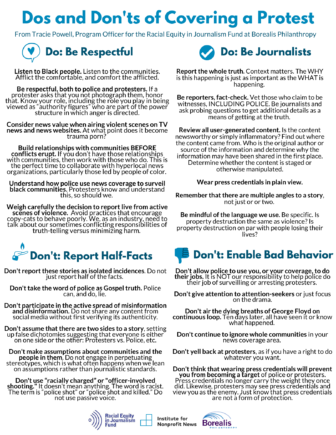On June 4, INN invited members to a webinar on how to navigate some of the ethical and legal challenges journalists are faced with in covering the current protests over police brutality after the death of George Floyd. Sarah Matthews, a senior staff attorney at the Reporters Committee for Freedom of the Press, and Tracie Powell, program officer, Racial Equity in Journalism Fund at Borealis Philanthropy, covered practical tips and guidance for reporters who are covering protests including a discussion of curfew rules/media exemptions as well as advice on how journalists can approach this protest story.

Because these topics are important to all journalists, we'd like to share how reporters can cover these protests in a respectful, responsible way. We thank Tracie Powell and the team at REJ, Borealis for sharing with us. Download as a PDF.
Do: Be Respectful
- Listen to Black people. Listen to the communities. Afflict the comfortable, and comfort the afflicted.
- Be respectful, both to police and protesters. If a protester asks that you not photograph them, honor that. Know your role, including the role you play in being viewed as “authority figures” who are part of the power structure in which anger is directed.
- Consider news value when airing violent scenes on TV news and news websites. At what point does it become trauma porn?
- Build relationships with communities BEFORE conflicts erupt. If you don’t have those relationships with communities, then work with those who do. This is the perfect time to collaborate with hyperlocal news organizations, particularly those led by people of color. Understand how we frame protests, either legitimizing or delegitimizing them on how we choose to focus on the substantive, or not.
- Understand how police use news coverage to surveil black communities. Protesters know and understand this, so should we.
- Weigh carefully the decision to report live from active scenes of violence. Could your very presence attract bad-behavior? Avoid practices that encourage copy-cats to behave poorly. We, as an industry, need to talk about our sometimes conflicting responsibilities of truth-telling versus minimizing harm.
Do: Be Journalists
- Report the whole truth. Context matters. The WHY is this happening is just as important as the WHAT is happening.
- Be reporters, fact-check. Vet those who claim to be witnesses, INCLUDING POLICE. Be journalists and ask probing questions to get additional details as a means of getting at the truth.
- Review all user-generated content. Is the content newsworthy or simply inflammatory? Find out where the content came from. Who is the original author or source of the information and determine why the information may have been shared in the first place. Determine whether the content is staged or otherwise manipulated.
- Wear press credentials in plain view.
- Remember that there are multiple angles to a story, not just one or two.
- Be mindful of the language we use. Be specific. Is property destruction the same as violence? Is property destruction on par with people losing their lives?
Don't: Report Half- Facts
- Don't report these stories as isolated incidences. Do not just report half of the facts.
- Don't take the word of police as Gospel truth. Police can, and do lie. Not all of them, but many of them LIE.
- Don't participate in the active spread of misinformation and disinformation. Do not share memes, videos, tweets, images, text posts, or any other content from social media without first verifying its authenticity.
- Don't assume that there are two sides to a story, setting up straw man arguments and false dichotomies suggesting that everyone is either on one side or the other: Protesters vs. Police; Victim vs Aggressor; Community vs Law Enforcement, etc….
- Don't make assumptions about communities and the people in them… Communities and people in which you have no prior relationship. Do not engage in perpetuating stereotypes, which is what often happens when we lean on assumptions rather than journalistic standards
- Don't use “racially charged.” It doesn’t mean anything. The word is racist. The same is true with “officer-involved shooting.” The term is “police shot” or “police shot and killed.” Do not use passive voice.
Don’t: Enable Bad Behavior
- Don't allow police to use you, or your coverage, to do their jobs. It is NOT our responsibility to help police do their job of surveilling or arresting protesters.
- Don't enable bad behavior by giving attention to attention-seekers.
- Don't air the dying breaths of George Floyd on a continuous loop. Ten days later, all have seen it or know what happened. We do not need to keep airing that over and over again.
- Don't continue to ignore whole communities in your news coverage area.
- Don't just focus on the drama.
- Don't yell back at protesters, “FIRST AMENDMENT” as if you have a right to do whatever you want.
- Don't think that wearing press credentials will prevent you from becoming a target of police or protesters. Police are targeting journalists, and press credentials no longer carry the weight they once did. Likewise, protesters may see press credentials and view you as the enemy. Journalists are often seen as part of the problem when it comes to systemic racism in this country. Just know that press credentials are not a form of protection.
Legal Resources for Journalists Covering Protests
- Reporters Committee for Freedom of the Press' guide, Police, Protesters, and the Press
- RCFP's tip sheet for covering protests
- National Press Photographers Association's guide, Some Practical Advice about Covering High Conflict News Stories
- Committee to Protect Journalists' safety advisory